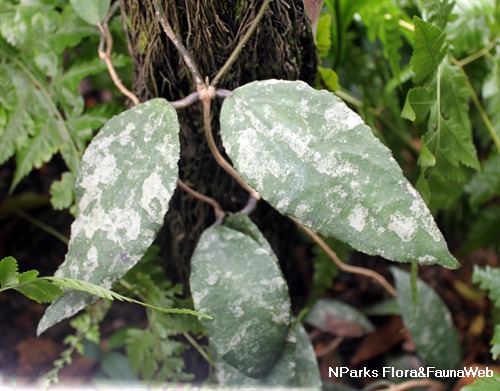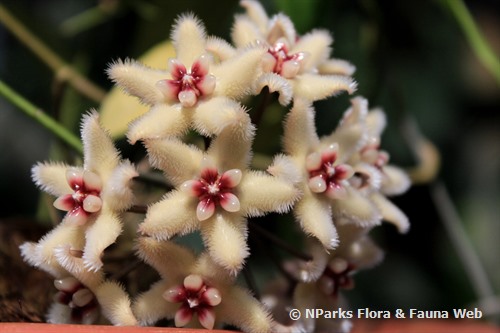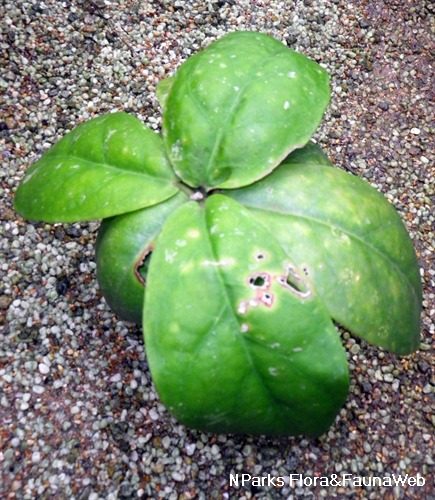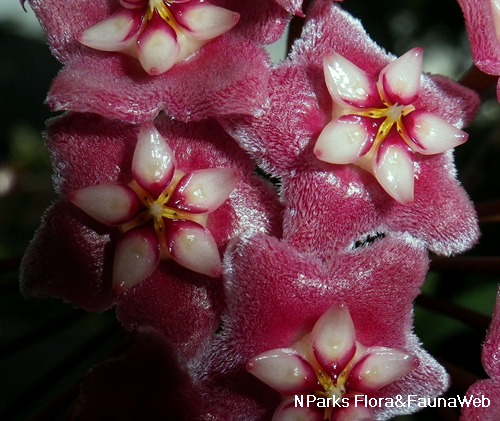_lowres.jpg)
Back
Hoya caudata Hook.f.
| Family Name: | Apocynaceae |
Hoya caudata is a critically endangered climber native in SIngapore. This climber can be found growing in very humid and shady forests of the tropical lowlands. Its distinct fuzzy textured, pink star-shaped flowers last just one to two days, adding to its elusive charm.
Name
Classifications and Characteristics
| Plant Growth Form | Climber |
|---|
Biogeography
| Native Distribution | Southern Thailand, Peninsular Malaysia, Singapore, Sumatra and Borneo |
|---|---|
| Native Habitat | Terrestrial |
| Preferred Climate Zone | Tropical |
| Local Conservation Status | Native to Singapore (Critically Endangered (CR)) |
Description and Ethnobotany
| Growth Form | Epiphytic climber with thin, wiry stems. |
|---|---|
| Roots | Adventitious roots produced along the whole stem. |
| Foliage | Fleshy, stiff leaves are ovate to elliptic, (6-) 10-15 x 3-6 cm. Upper surface is medium green and typically has grey spots, while lower surface is a lighter green. Young leaves dull reddish brown with dull grey markings. Plants exposed to very bright light or full sun may have leaves that are completely red in color. |
| Flowers | Flower resembles a light pink star (the corolla made of hairy petals, 10-12 mm wide) with a smaller, reddish star on top (the staminal corona, dark red in the centre and light red near the tip, 6-7 mm wide). The pollen-producing anther has long, thin, 'tail like' appendages to 3 mm long that are raised above the corona. The inflorescence is composed of 8-12 flowers. |
| Habitat | It is often found in lowland primary forest near streams. It has only been observed in Nee Soon swamp forest in Singapore. |
| Etymology | The specific epithet caudata refers to the 'tail-like' (caudate) appendages of the anther emerging from the centre of the corona. |
Landscaping Features
| Desirable Plant Features | Ornamental Flowers, Ornamental Foliage, Ornamental Form |
|---|---|
| Landscape Uses | Small Gardens, Vertical Greenery / Green Wall, Skyrise / Balcony, Container Planting, Suitable for Hanging Baskets |
| Usage Hazard - Cons | Toxic Upon Ingestion |
| Usage Hazard - Cons Remarks | Avoid contact with milky/ white sap as it may cause skin irritation in certain individuals. Keep plants away from children and pets as sap could be toxic. |
Fauna, Pollination and Dispersal
| Pollination Method(s) | Biotic (Fauna) |
|---|
Plant Care and Propagation
| Light Preference | Full Sun, Semi-Shade |
|---|---|
| Water Preference | Moderate Water, Occasional Misting |
| Rootzone Tolerance | Moist Soils, Well-Drained Soils, Easy to Grow |
| Pest(s) | Sucking Insects |
| Propagation Method | Seed, Stem Cutting |
Foliar
| Foliage Retention | Evergreen |
|---|---|
| Mature Foliage Colour(s) | Brown, Green, Green - Light Green, Patterned |
| Mature Foliage Texture(s) | Leathery |
| Prominent Young Flush Colour(s) | Brown, Green - Light Green, Red, Patterned |
Floral (Angiosperm)
| Flower Colour(s) | Pink, Red, White |
|---|---|
| Flower Texture(s) | Hairy / Hirsute |
| Flower Grouping | Cluster / Inflorescence |
| Flower Symmetry | Radial |
| Individual Flower Shape | Stellate / Star-shaped |
| Inflorescence Type | Umbel |
| Flower Size | 2.5 mm x 11 mm |
Image Repository
Others
| Master ID | 32011 |
|---|---|
| Species ID | 6413 |
| Flora Disclaimer | The information in this website has been compiled from reliable sources, such as reference works on medicinal plants. It is not a substitute for medical advice or treatment and NParks does not purport to provide any medical advice. Readers should always consult his/her physician before using or consuming a plant for medicinal purposes. |

_lowres.jpg)








